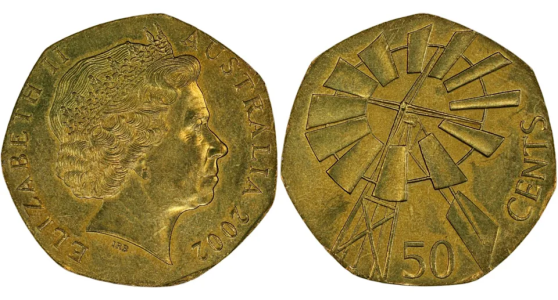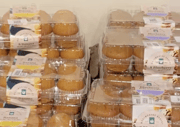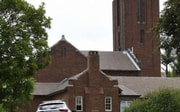Rare 50-cent coin sells for over $3,000—check your change now
By
Gian T
- Replies 0
If you’ve ever idly jingled a handful of coins in your pocket and wondered if they might be worth more than their face value, you’re not alone.
In fact, one lucky Aussie recently discovered that a humble 50-cent coin was actually a hidden treasure, fetching a jaw-dropping $3,050 at auction!
And the reason is a genuinely unique minting mistake that has collectors buzzing.
The star of this story is a 2002 Australian 50-cent coin, but with a twist: it was accidentally struck on a Samoan Tala blank.
For those not up on their Pacific currencies, the Samoan Tala is a seven-sided coin made from nickel brass, quite different from our standard 50-cent pieces.
This mix-up resulted in a coin that’s not only a different shape but also a different colour and weight, making it a real oddity in the world of numismatics.
Scott Waterman, director at Roxbury’s Auction House, was the lucky auctioneer to handle this rare find. He said, ‘It’s very, very unusual… unique as I understand it. So anything that is unique is literally there’s one of it.’
You might be wondering how such a blunder could occur. Well, the Royal Australian Mint doesn’t just make coins for Australia; it also mints coins for other countries in the region.
Every now and then, a blank intended for another nation sneaks into the wrong batch, and voilà—a collector’s dream is born.
Waterman described the error as ‘pretty crazy’ and ‘very unusual’.
While error coins are rare in Australia, they do pop up from time to time, and when they do, collectors are willing to pay top dollar.
In fact, Australia’s error coins are so well regarded that they often fetch higher prices than similar mistakes from other countries.
This isn’t the first time a coin with a minting error has made waves. Take, for example, the 2000 $1 coin that was struck with a 10-cent die on one side—a so-called ‘mule coin’.
In uncirculated condition, one of these sold for $1,150, while a circulated version still managed to fetch $375. Not bad for a coin you might find in your change!
And let’s not forget the infamous ‘double-headed’ 5-cent coin, which has been valued at up to 25,000 times its face value.
These stories serve as a reminder that sometimes, the most valuable treasures are hiding in plain sight.
The value of error coins comes down to rarity and demand. The fewer there are, the more collectors want them. Australia’s relatively strict quality control means that genuine errors are few and far between, making them even more desirable when they do surface.
Collectors are always on the lookout for coins with off-centre strikes, double images, or mismatched dies.
If you spot something odd about a coin in your wallet—maybe it’s a strange colour, shape, or design—it’s worth looking closer. You could be holding onto a small fortune!
 Have you ever stumbled across a rare or unusual coin in your change? Do you have a coin collection, or are you considering starting one? Share your stories, tips, and questions in the comments below.
Have you ever stumbled across a rare or unusual coin in your change? Do you have a coin collection, or are you considering starting one? Share your stories, tips, and questions in the comments below.
Read more: Rare $2 coin could sell for thousands—do you have one in your pocket?
In fact, one lucky Aussie recently discovered that a humble 50-cent coin was actually a hidden treasure, fetching a jaw-dropping $3,050 at auction!
And the reason is a genuinely unique minting mistake that has collectors buzzing.
The star of this story is a 2002 Australian 50-cent coin, but with a twist: it was accidentally struck on a Samoan Tala blank.
For those not up on their Pacific currencies, the Samoan Tala is a seven-sided coin made from nickel brass, quite different from our standard 50-cent pieces.
This mix-up resulted in a coin that’s not only a different shape but also a different colour and weight, making it a real oddity in the world of numismatics.
Scott Waterman, director at Roxbury’s Auction House, was the lucky auctioneer to handle this rare find. He said, ‘It’s very, very unusual… unique as I understand it. So anything that is unique is literally there’s one of it.’
You might be wondering how such a blunder could occur. Well, the Royal Australian Mint doesn’t just make coins for Australia; it also mints coins for other countries in the region.
Every now and then, a blank intended for another nation sneaks into the wrong batch, and voilà—a collector’s dream is born.
Waterman described the error as ‘pretty crazy’ and ‘very unusual’.
While error coins are rare in Australia, they do pop up from time to time, and when they do, collectors are willing to pay top dollar.
In fact, Australia’s error coins are so well regarded that they often fetch higher prices than similar mistakes from other countries.
This isn’t the first time a coin with a minting error has made waves. Take, for example, the 2000 $1 coin that was struck with a 10-cent die on one side—a so-called ‘mule coin’.
In uncirculated condition, one of these sold for $1,150, while a circulated version still managed to fetch $375. Not bad for a coin you might find in your change!
These stories serve as a reminder that sometimes, the most valuable treasures are hiding in plain sight.
The value of error coins comes down to rarity and demand. The fewer there are, the more collectors want them. Australia’s relatively strict quality control means that genuine errors are few and far between, making them even more desirable when they do surface.
Collectors are always on the lookout for coins with off-centre strikes, double images, or mismatched dies.
If you spot something odd about a coin in your wallet—maybe it’s a strange colour, shape, or design—it’s worth looking closer. You could be holding onto a small fortune!
Key Takeaways
- A rare 2002 50-cent coin mistakenly struck on a Samoan Tala coin sold at auction for $3,050, making it extremely valuable to collectors due to its unique minting error.
- The error coin is considered totally unique, with no other known examples, and was described as 'pretty crazy' and 'very unusual' by auctioneer Scott Waterman.
- Error coins have become highly sought-after in Australia, with collectors willing to pay significant amounts for these rare mistakes, mainly as they occur less frequently compared to other countries.
- Other Australian coins struck using the wrong die, like a 2000 $1 coin with a 10-cent die, have also fetched high prices at auction, being known as 'mule coins'.
Read more: Rare $2 coin could sell for thousands—do you have one in your pocket?








